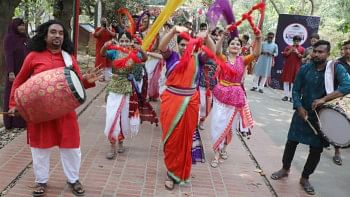Our dying rivers
RIVERS are the lifeblood of the Bangladesh economy and social life. Its cultural life is also deeply related to rivers. It is extremely unfortunately that its three main rivers, Ganges-Padma, Brahmaputra-Jamuna and Surma-Meghna are dying. We see cultivation of paddy on the bed of Jamuna and mustard and potato on the bed of Meghna.
As per a survey of the Bangladesh Water Development Board (BWDB), there are three hundred and ten rivers in Bangladesh. Out of these fifty-seven are border rivers, the condition of one hundred and seventy five is miserable, and sixty five are almost dead. Eighty percent of the rivers lack proper depth. The latest study of BIWTA reveals that one hundred and seventeen rivers are either dead or have lost navigability . Such rivers/canals include Brahamaputra, Padma, Mahananda, Gorai, Meghna, Titas, Gomati, Kushiara, Dhaleswari, Bhairab, Sitalksha, Turag etc.
As per a report of BWDB, India is controlling the water of 57 rivers along with the Farakka barrage. Because of inadequate facilities for dredging, these rivers have become canals. Additionally, India has withdrawn water of several rivers including Surma, Kushiara and Mahananda. Sluice gates have been constructed on the rivers Senoa, Jamuna, Panga, Pan, Hatoori and Sui (situated near Panchagarh).
Apart from the scourge of Farakka barrage, a new dam, named Tipaimukh dam, is under construction in India. Our survival depends on saving our rivers. The following steps may be considered at this stage:
-Increasing our capacity for regular dredging ;
-Stopping dumping of effluents in the rivers;
-Cleaning the effluents already dumped; and
-Continuous cleaning of river beds.
India has proceeded with the construction of fifty-two dams to produce electricity. However, it is reported that neither the ministry of irrigation nor any private research organisation of Bangladesh is aware of these developments in India.
Already 75 percent of our river routes have lost navigability due to silting. To obviate the problem of lack of capacity to dredge them, it appears to be advisable to try greater utilisation of our idle manpower through food for work program in addition to continuous dredging with our available resources.
This needs, of course, planned dredging, river training and socio-economic development. Another less costly device may be "bundling" through utilisation of bamboo and chatai (mat). However, it needs vigorous concerted effort by BIWTA, Buet and River Research Institute to make such a project successful.
Killing of rivers in Bangladesh started from the Farakka Agreement in 1974. We are not certain about water flow of 54 rivers. Our Joint River Commission appears to be rather ineffective. Saarc so far could not bring us any real benefit. Even our membership of Bimstec has not been of much significance to our need.
From our past experience we may say that we see only raising of high hopes and aspirations on completion of high-level bilateral meetings with India.
How much we have been benefited from these meetings is a moot point.
We have to take a look at our statistical base too. It appears that during the last 36 years (1974-2010) we have not been able to make any headway in the field of statistics, particularly statistics about rivers. It is reported that in the bilateral meetings with India we depend mainly on Indian statistics, which are vastly superior to ours. Even in recent high-level meetings we had to depend mainly (if not wholly) on Indian statistics. Thus, the decisions of such meetings are usually favourable to India. We must take immediate measures to improve our miserable position.
Our rivers are dying. This will result in immense suffering for the whole nation. Thus, the government needs the support of the whole nation for our survival. We must not dilly-dally with such an issue. We have waited for 36 years and failed to solve the problem bilaterally. It appears that we have no option except taking the matter before the UN to draw the attention of the world community to our miserable plight. We want dispensation of justice, not favour or benevolence.

 For all latest news, follow The Daily Star's Google News channel.
For all latest news, follow The Daily Star's Google News channel. 



Comments